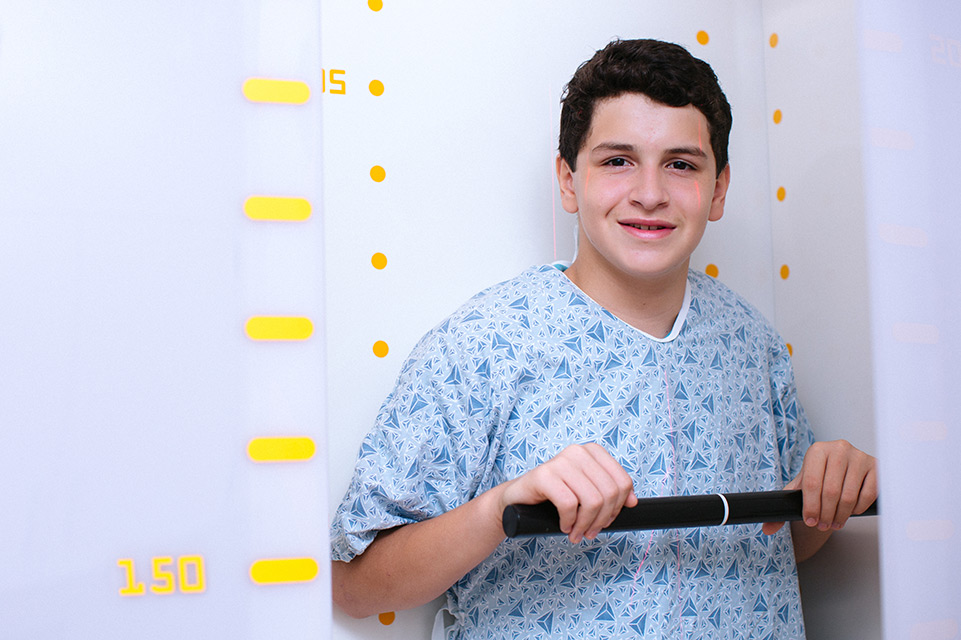Spondylolisthesis
Shriners Children's medical team can help get your child's future back on track.
Spondylolisthesis is a condition in which a vertebra, weakened by fracture, slips out of alignment with the rest of the spine. It is closely related to another back condition that Shriners Children's physicians are highly skilled in treating, spondylosis.
Most cases of spondylolysis and spondylolisthesis are repetitive stress injuries that develop during intense athletic training. Athletes who participate in sports that put repeated pressure on the lower back, such as gymnastics, basketball, rowing, diving, downhill ski racing and weightlifting, are particularly prone to this condition. As the athlete’s muscles become overly fatigued, the stress of the workload is transferred to their bones. Over time, the continued pressure can cause stress fractures in the lower back.
Your Shriners Children's physician will perform a thorough history and physical exam, have X-rays taken and discuss with you the details of your child's condition. Together, you will develop a personalized treatment plan that may include observation, temporary limits on physical activity, bracing, physical therapy or surgery.
Athletes with either condition can usually return to sports after several months of rest and physical therapy. Your child may need to wear a back brace as part of their recovery. In rare situations, if a vertebra is severely out of alignment or if your child remains in pain after other forms of treatment, they may need spinal fusion surgery from one of our skilled, experienced physicians.
Specific treatments and services may vary by location. Please contact a specific location for more information.
Spondylosis vs. Spondylolysis vs. Spondylolisthesis
Three similar words, but three different conditions
Spondylosis is different from spondylolysis and spondylolisthesis. Spondylosis occurs when cartilage, disks, ligaments and bones in your child's neck wear down. Poor posture, obesity and lack of exercise can enhance the problem.
Spondylolysis is a stress fracture in the lower back. Repetitive stress from sports can put kids at risk. Both spondylolysis and spondylolisthesis may cause low back pain.
Spondylolisthesis happens when a vertebra, weakened from a stress fracture, moves forward, slipping out of alignment from the rest of the spine.
What Causes Spondylolisthesis?
Repetitive Stress
Most cases of spondylolisthesis are repetitive stress injuries that develop during intense athletic training. Athletes who participate in sports that put repeated pressure on the lower back are particularly prone to these overuse injuries of the spine. As the athlete’s muscles become overly fatigued, the stress of the workload is transferred to their bones. Over time, the continued pressure can cause stress fractures in the lower spine.
Genetic Causes
Some children are born with fragile spines that can fracture in the course of normal childhood activities. These children may have lower spine fractures by the age of 5 or 6, usually with no signs or symptoms. Typically, they are diagnosed only if their doctor orders an X-ray for another back issue.
What Are the Symptoms?
Symptoms of spondylolisthesis include:
- Low back pain that increases during physical activity
- Pain that spreads to the buttocks and down the back of the thighs
- Tight hamstrings
- Muscle spasms in the back of the thighs (hamstrings)
- Tight hamstrings that may force your child to walk in shorter strides
- Numbness or tingling sensations in the foot
It’s important to note that low back pain is often a symptom of muscle strain, not a fracture. Either way, if your child has low back pain, make an appointment to see a Shriners Children's physician. Prompt treatment can help resolve your child's pain and prevent the injury from progressing.
Your First Appointment: What to Expect
Our philosophy is to focus on all the options for your child. Your Shriners Children's physician will perform a thorough history and physical examination, have X-rays taken and go over the details of your child's condition.
Then, you and your physician will develop a personalized treatment program for your child. This plan may include medication, steroid injections, physical therapy or bracing.
I’m playing the game I love. There was a time when I thought I might not be able to do that.

We'll Get Your Child Back in the Game
Services We Provide
View All Related Services
Athletic Training

Care Management

Bracing


